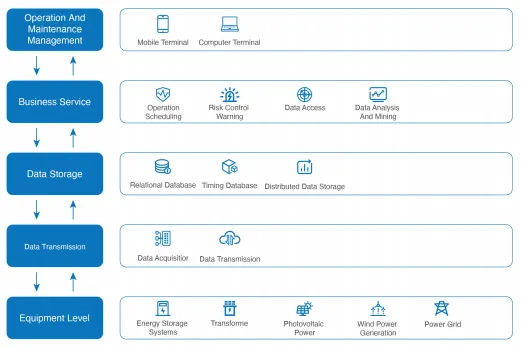
Juil . 03, 2025 14:07 Retour à la liste
Smart Grid Management for Rural Electrification
In rural regions worldwide, access to reliable, affordable electricity remains a critical challenge. Uneven infrastructure, scattered populations, and reliance on traditional energy sources often lead to inconsistent power supply, hindering economic growth and quality of life. Enter smart grid management—a transformative approach that combines advanced technology with intelligent systems to revolutionize rural electrification. By integrating energy management system (EMS) capabilities and bms energy (battery management system energy) storage solutions, these frameworks address the unique demands of rural grids, ensuring stable power flow, optimizing resource use, and paving the way for sustainable development. This article explores how these integrated solutions are bridging the rural-urban energy divide, enhancing resilience, and driving long-term efficiency.

Smart Grid Management as the Foundation for Rural Electrification
Smart grid management serves as the backbone of modern rural electrification, enabling precise control over energy generation, distribution, and consumption in geographically dispersed areas. Unlike conventional grids, which rely on static infrastructure and reactive troubleshooting, smart grids leverage real-time data analytics, IoT sensors, and automated controls to monitor grid health and adapt to changing conditions. For rural communities to rely on decentralised renewable energy sources such as small wind or solar installations,this means detecting equipment faults instantly, rerouting power during outages, and optimizing energy flow to remote households and businesses.
A key advantage of smart grid management in rural settings is its ability to integrate diverse energy sources into a unified network. Whether connecting microhydro plants, biomass generators, or rooftop solar panels, these systems standardize data collection and communication protocols, ensuring seamless coordination across hybrid energy setups. This not only reduces dependence on costly diesel generators but also creates a more flexible grid that can scale with growing energy demands. For agricultural operations in rural areas, which often require reliable power for irrigation pumps, cold storage, and processing facilities, smart grids minimize downtime, protect equipment from voltage fluctuations, and enable predictive maintenance—ultimately boosting productivity and profitability.
Optimizing Energy Distribution with Energy Management System in Rural Grids
At the heart of efficient rural grid operations lies the energy management system (EMS), a technology designed to balance supply and demand while maximizing resource utilization. In regions where energy generation from renewables can be intermittent—such as cloudy days affecting solar output or low winds reducing turbine efficiency—an EMS acts as a strategic coordinator, prioritizing energy use, storing excess power, and tapping into backup sources when needed. By analyzing historical consumption data, weather patterns, and seasonal demands, it predicts peak usage periods (e.g., evening hours when households and farms are most active) and adjusts energy distribution accordingly, preventing waste and ensuring critical loads are always supplied.
Energy management system solutions also excel at reducing operational costs for rural utilities. By identifying inefficiencies like power leakage in aging transmission lines or inefficient generator usage, they recommend targeted upgrades, such as replacing outdated transformers or implementing smart metering to monitor real-time consumption. For rural communities with limited financial resources, this translates to lower energy bills, as the system optimizes tariff structures based on actual usage patterns—offering discounted rates during off-peak hours to encourage flexible consumption. Moreover, the centralized control provided by an EMS simplifies grid management for utility operators, allowing them to monitor multiple substations and distribution points from a single interface, reducing the need for manual inspections and speeding up response times to emergencies.
Enhancing Grid Resilience with BMS Energy Storage in Rural Areas
Rural grids often lack the redundancy of urban systems, making them more vulnerable to disruptions from natural disasters, equipment failures, or seasonal fluctuations in energy supply. Bms energy storage solutions address this challenge by acting as dynamic buffers, storing excess energy generated during periods of high production (e.g., midday solar surpluses or nighttime wind peaks) and releasing it during shortages. Integrated with smart grid controls, these systems automatically detect supply gaps and deploy stored energy to maintain uninterrupted service, ensuring rural households and businesses never face prolonged outages.
The benefits of bms energy storage extend beyond reliability. In rural areas embracing renewable energy, these systems capture otherwise wasted energy—such as solar power generated when demand is low—and convert it into usable reserves for high-demand periods. This not only maximizes the utilization of clean energy but also reduces the need for expensive fossil fuel backups, aligning with global sustainability goals. For remote villages transitioning to electrification, battery storage paired with smart grid management creates a self-sufficient ecosystem that can operate independently during grid outages, relying on stored renewable energy to power essential services like healthcare clinics, schools, and water pumps. Over time, the reduced wear and tear on generation equipment—thanks to stabilized energy demand—leads to longer asset lifespans and lower maintenance costs, making the entire system more economically viable.
FAQ: Unlocking the Potential of Smart Grid Management Solutions for Rural Electrification
How do smart grid management systems benefit rural communities compared to traditional grids?
Smart grid management offers unmatched visibility and control, enabling real-time monitoring of energy flow, quick fault detection, and adaptive resource allocation. Unlike traditional grids, which rely on manual interventions and static schedules, these systems optimize energy use based on actual needs, reducing waste, cutting costs, and improving reliability—especially crucial for rural areas with limited infrastructure. By integrating energy management system et bms energy storage, they create a resilient, sustainable framework that grows with community needs, supporting both daily life and economic activities.
Can an energy management system work with existing rural power infrastructure?
Absolutely. Modern energy management system solutions are designed with modular, scalable architectures that seamlessly integrate with legacy equipment, whether outdated transformers, manual switches, or mixed energy sources. Open communication protocols allow gradual upgrades—such as adding smart meters or IoT sensors to existing grids—without disrupting service, making them ideal for rural regions prioritizing phased investments. This flexibility ensures a smooth transition to smarter, more efficient energy management without high upfront costs.
How does BMS energy storage improve the reliability of rural power supply?
Bms energy storage acts as an insurance policy for rural grids, storing excess renewable energy during peak production and releasing it during shortages. This buffers against the intermittency of solar and wind power, ensuring a steady supply even when generation fluctuates. During outages or emergencies, it can power critical loads independently, reducing dependence on unreliable diesel generators. By extending the lifespan of both storage devices and generation equipment through intelligent charging algorithms, it also minimizes downtime and maintenance hassles, delivering consistent performance for years.
What cost savings can rural utilities expect from smart grid management integrated solutions?
The savings are multi-faceted. Smart grid management reduces energy waste through optimized distribution, while energy management system analytics identify inefficiencies and recommend cost-effective upgrades. Bms energy storage allows utilities to capitalize on off-peak energy prices, store excess renewable power for later use, and cut spending on fossil fuel backups. Over time, lower operational costs, extended equipment lifespans, and reduced maintenance fees translate to a strong return on investment—making these solutions not just sustainable, but financially smart for rural energy providers.
Is technical support available for implementing smart grid management solutions in remote rural areas?
Yes, end-to-end support is built into every solution. Expert teams work closely with rural clients to assess unique needs—from terrain challenges to local energy habits—designing customized systems that fit existing workflows. During deployment, technicians ensure seamless integration and provide training for local operators, while post-installation support includes 24/7 monitoring, software updates, and responsive troubleshooting. This comprehensive approach ensures that even the most remote rural communities can adopt and maintain these advanced systems with confidence, unlocking the full potential of smart grid electrification.
As the world prioritizes equitable access to energy, smart grid management paired with energy management system et bms energy storage emerges as the ultimate solution for rural electrification. These technologies not only overcome the challenges of scattered populations and unreliable supply but also foster sustainable growth, reduce operational costs, and enhance quality of life. For rural communities ready to embrace a brighter, more efficient future, the path is clear: invest in integrated smart grid solutions to build a resilient, affordable, and environmentally friendly energy infrastructure that powers progress for generations to come.
Ceci est le dernier article
-
Smart Grid Management for Rural Electrification
NouvellesJul.03,2025
-
Energy Management System Battery Storage for Renewable Integration
NouvellesJul.03,2025
-
Energy Control Systems in Public Transportation Networks
NouvellesJul.03,2025
-
Electrical Energy Management System for Electric Vehicle Charging
NouvellesJul.03,2025
-
BMS Energy Retrofitting for Aging Infrastructure
NouvellesJul.03,2025
-
Adaptive Energy Control Systems for Weather Variability
NouvellesJul.03,2025























